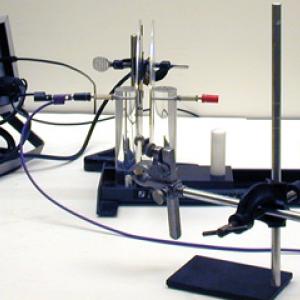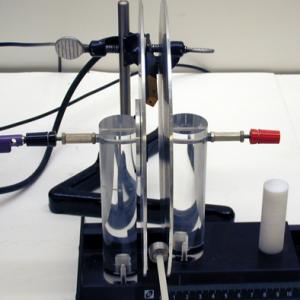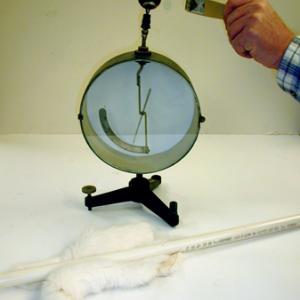College of Liberal Arts & Sciences
5D40.30 - Radioactive Discharge - Ionization
Set the plate at about 2 cm separation and insert the electrostatic voltmeter probe as far as possible. Charge the parallel plates with the high voltage source to a potential of 1 to 2000 volts as measured by the voltmeter. Wait a few seconds to show that the voltage applied is not leaking off. Then bring the americium or polonium source toward the separation of the plates. When the source gets within 6 cm of the plate the voltage should start to decrease. The closer the source is to the plates the faster the discharge rate.
NOTE: This works best during the winter months when there is lower humidity.
A less intensive way to do this is to charge one of the electroscopes negatively with the cat's fur and PVC rod. Bring the brush that has the polonium 210 source in it near to the ball of the electroscope and observe the discharge.
The brush with the Polonium 210 source can be purchased from the camera store. It is used to neutralize the static from dust so that it can be wiped away. The source will last for several years before it needs to be replaced. It is a very convenient source of alpha particles that can be used for several demonstrations.
- S-130: "Dischg. - Flame & Radioactivity", DICK and RAE Physics Demo Notebook.
- "Thoron Decay", The Demonstration Physicists Companion, Harvard University.
- K.T. Bainbridge and J.C. Street, "Laboratory and Demonstration Experiments on the Law of Radioactive Decay and the Determination of the Disintegration Constant of Thoron", AJP, Vol. 6, 99, 1938.
- "An Electrostatic 'Compass'", Physics From the Junk Drawer 3rd Edition, The Science House, North Carolina State University, p. 31.
- Rudolf F. Graf, "Discharging Your Electroscope by Radiation or Ionization", Safe and Simple Electrical Experiments, p. 14.
- W. Bolton, "The Ionizing Properties of the Radiations (1)", Book 3 - Atomic Physics, Physics Experiments and Projects, 1968, p. 35-36.
- W. Bolton, "The Ionizing Properties of the Radiations (2)", Book 3 - Atomic Physics, Physics Experiments and Projects, 1968, p. 37-38.
- W. Bolton, "The Range of Alpha Particles", Book 3 - Atomic Physics, Physics Experiments and Projects, 1968, p. 39-40.
Disclaimer: These demonstrations are provided only for illustrative use by persons affiliated with The University of Iowa and only under the direction of a trained instructor or physicist. The University of Iowa is not responsible for demonstrations performed by those using their own equipment or who choose to use this reference material for their own purpose. The demonstrations included here are within the public domain and can be found in materials contained in libraries, bookstores, and through electronic sources. Performing all or any portion of any of these demonstrations, with or without revisions not depicted here entails inherent risks. These risks include, without limitation, bodily injury (and possibly death), including risks to health that may be temporary or permanent and that may exacerbate a pre-existing medical condition; and property loss or damage. Anyone performing any part of these demonstrations, even with revisions, knowingly and voluntarily assumes all risks associated with them.


